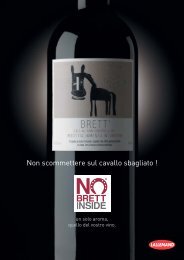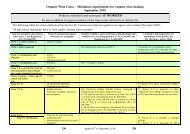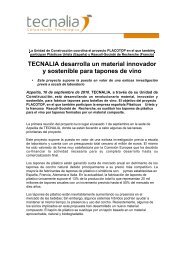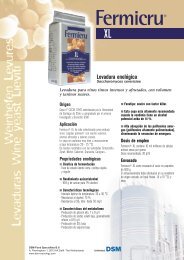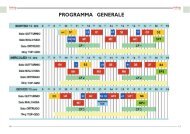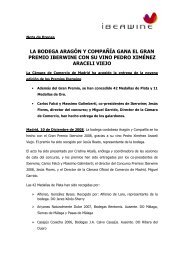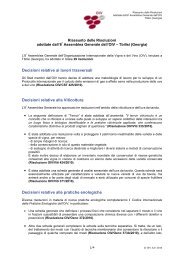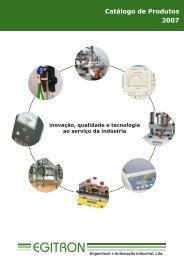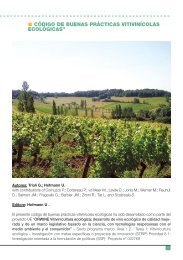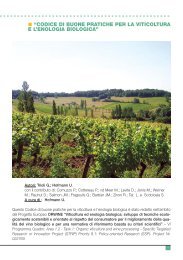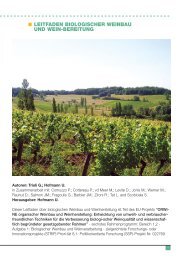Stabtar - InfoWine.Com
Stabtar - InfoWine.Com
Stabtar - InfoWine.Com
You also want an ePaper? Increase the reach of your titles
YUMPU automatically turns print PDFs into web optimized ePapers that Google loves.
CARATTERISTICHE TECNICHE STABTARSTABTAR TECHNICAL CHARACTERISTICSKREATTIVA .euPARAMETRIPARAMETERSMODELLO 100MODEL 100MODELLO 200MODEL 200MODELLO 400MODEL 400Portata (hl/ora)Delivery Capacity (hl/hour)20 - 40 35 - 80 70 - 110Tempo di rigenerazione (minuti)Regeneration time (min)Ciclo completo MEDIO (minuti)full cycle (average min)Hl lavorati in giornata* (al 10%)**Hl processed in one day* (at 10%)**Hl lavorati in giornata* (al 20%)**Hl processed in one day* (at 20%)**30 - 35 45 - 55 65 - 70110 110 1251000 - 2000 2000 - 3500 2800 - 4200500 - 1000 1000 - 1750 1400 - 2100* giornata intesa come 8h di lavoro in automatico in continuo** 10% o 20% in dipendenza dalle esigenze* As 8 hours of process in automatic and in continuous** 10% o 20% depending on needs
PRINCIPIO CHIMICOLa perfetta stabilizzazione di un vino prima della sua messa inbottiglia è uno degli aspetti che richiedono maggior cura daparte dell’enologo e, sicuramente, la stabilizzazione tartarica èun punto chiave, per cui la possibilità di rimozione di ioni potassioe calcio dal vino è considerata con estremo interesse.(RESINA - H + ) + K + -> (RESINA - K + ) + H +Tipicamente le RESINE CATIONICHE scambiano unidrogenione H + presente sul gruppo funzionale con i cationipresenti in soluzione (K + , Ca ++ , Fe ++ , Cu ++ …etc.). A finereazione il vino risulta impoverito dei propri cationi e ricco di ioniidrogeno (quindi acido). Esaurita la capacità di scambio dellaresina, si esegue un controlavaggio per la rimozione di eventualisedimenti e si procede alla sua rigenerazione.CHEMICAL PRINCIPLEA perfect stabilization of a wine, before its bottling, is one of theaspects that require major care by the winemaker and certainlythe tartaric stabilization is a key aspect; for these reasons, thepossibility of removing potassium and calcium ions from wineis considered with extreme interest.(RESIN - H + ) + K + -> (RESIN - K + ) + H +Typically CATIONIC RESIN exchange an H + ion, present in thefunction group, with the cations present in solution (K + , Ca ++ ,Fe ++ , Cu ++ …etc.). At the end of the reaction the wine resultspoorer of its own original cations and richer in hydrogen ions(and therefore more acid).Once exhausted the exchange capacity of the resin, a backwashwill be performed in order to remove possible sediments andthen we will proceed to its regeneration.INGRESSO VINOwine inletUSCITA VINOwine outletDisegno dello spaccato di una bombola con flusso vino.Sketch of the cutaway of a container with wine.APPLICAZIONE• Vino (trattamento di parte della massa e reintegro nelvolume totale)• Mosto parzialmente fermentatoAPPLICATION• Wine (treatment of a part of the mass and reinstate backin the total volume)• Partially fermented mustVANTAGGI ENOLOGICI CHIMICI• Abbassamento della concentrazione di ioni calcio e potassio,con conseguente raggiungimento della stabilità tartarica• Abbassamento del pH, quindi minore rischio difermentazione malolattica• Abbassamento della concentrazione di Ferro e dei metalli ingenerale (riduzione del rischio di casse ferrosa e rameica)• Aumento dell’acidità totaleVANTAGGIENOLOGICI QUALITATIVI• Aumento della freschezza del vino• Stabilizzazione aromatica• Diminuzione dell’amaro• Miglior equilibrio organoletticoENOLOGICAL ANDCHEMICAL ADVANTAGES• Lowering potassium and calcium concentration andtherefore achievement of tartaric stability• Lowering pH and therefore less risk of malolacticfermentation• Lowering the Iron concentration as well as metals in general(reduction of ferric and cupric precipitation)• Increase of total acidityQUALITYENOLOGICAL ADVANTAGES• Enhancement of the wine freshness• Aroma stabilization• Reduction of bitterness sensation• Better organoleptic balanceTRATTAMENTO VINI CON STABTARSTABTAR TREATMENT TO WINESCAMPIONESAMPLEpHPERCHÈ SCEGLIERE STABTAR+ ++• Estrema selettività della resina nei confronti di K e Ca• Tempi di rigenerazione molto brevi• Basso consumo di acido per la rigenerazione delle resine• Utilizzo di acqua di rete• Modularità della macchina: espandibile da 30 hl/ora a110 hl/ora (A)• Modularità su vino bianco e rosso• Controllo in/out di pH e conducibilità (B)• Gestione con mini PC touch screen (sistema operativoLINUX)• Gestione completamente automatica (C)• Programmabile su esigenze particolari• Software aggiornabile e possibilità di trasferimento daticon dispositivo USB• Possibilità di check up on lineWHY TO CHOSE STABTAR•+ ++Extreme selectivity of the resin versus K and Ca• Very short regeneration times• Low consumption of acid dedicated to resinsregeneration• Use of normal water from existing water system• Modular structure of the machine: extendable from 30 hl/hour to 110 hl/hour (A)• Modular structure on white and red wine• In/Out check on pH and conductivity (B)• Running through a mini-PC touch screen (LINUX operativesystem)• <strong>Com</strong>pletely automatic management (C)• Programmable for particular demands• Updatable software and possibility of transferring datathrough a USB device• Possibility of on line check upACIDITÀ TOTALETOTAL ACIDITYK +(g/l)Ca ++(mg/l)ALCOL(% V/V)PINOT GRIGIO 3,34 4,5 0,80 98 11,78PINOT GRIGIO TRATTATO AL 20%PINOT GRIGIO BLEND 20%3,10 5,0 0,66 82 11,76PROSECCO 3,22 4,6 0,76 80 10,00PROSECCO TRATTATO AL 25%PROSECCO BLEND 25%2,92 5,1 0,54 61 9,97MOSCATO 3,19 4,2 0,96 101 4,14MOSCATO TRATTATO AL 20%MOSCATO BLEND 20%3,00 4,5 0,83 85 4,15ACB



